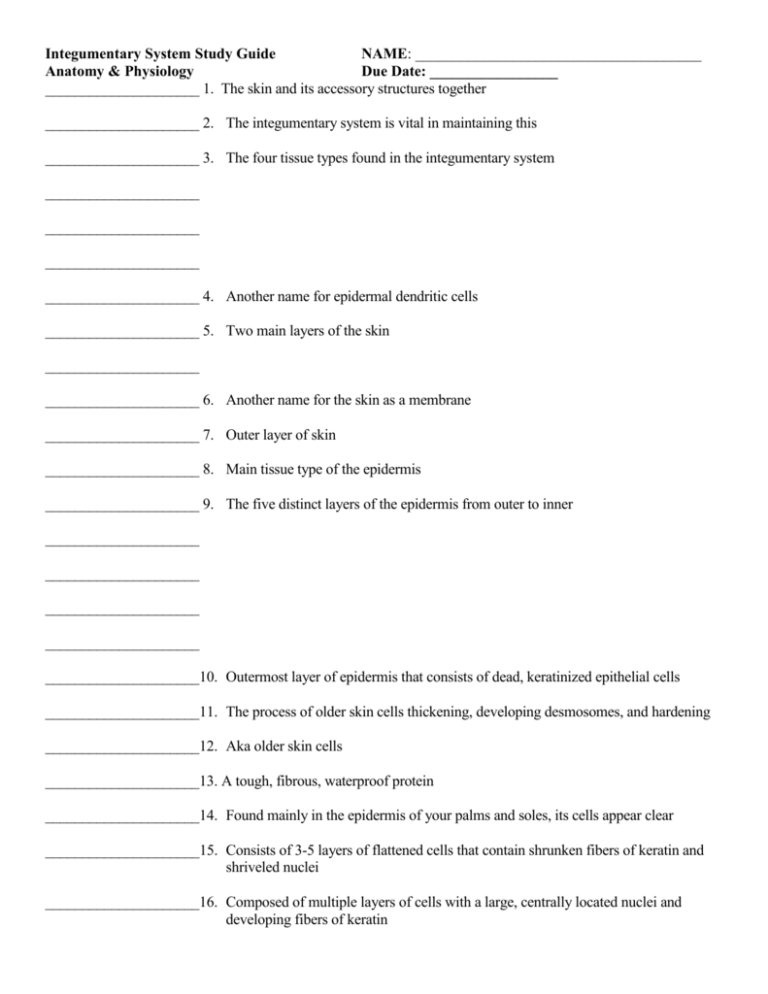BIOLOGY II
advertisement

Integumentary System Study Guide NAME: ______________________________________ Anatomy & Physiology Due Date: _________________ _____________________ 1. The skin and its accessory structures together _____________________ 2. The integumentary system is vital in maintaining this _____________________ 3. The four tissue types found in the integumentary system _____________________ _____________________ _____________________ _____________________ 4. Another name for epidermal dendritic cells _____________________ 5. Two main layers of the skin _____________________ _____________________ 6. Another name for the skin as a membrane _____________________ 7. Outer layer of skin _____________________ 8. Main tissue type of the epidermis _____________________ 9. The five distinct layers of the epidermis from outer to inner _____________________ _____________________ _____________________ _____________________ _____________________10. Outermost layer of epidermis that consists of dead, keratinized epithelial cells _____________________11. The process of older skin cells thickening, developing desmosomes, and hardening _____________________12. Aka older skin cells _____________________13. A tough, fibrous, waterproof protein _____________________14. Found mainly in the epidermis of your palms and soles, its cells appear clear _____________________15. Consists of 3-5 layers of flattened cells that contain shrunken fibers of keratin and shriveled nuclei _____________________16. Composed of multiple layers of cells with a large, centrally located nuclei and developing fibers of keratin Integumentary System Study Guide Anatomy & Physiology NAME: ______________________________________ Due Date: _________________ _____________________17. The deepest layer of the epidermis, consisting of cuboidal or columnar cells _____________________18. Specialized cells that produce melanin _____________________19. Layer of skin beneath the epidermis _____________________20. The two distinct layers of the dermis _____________________ _____________________21. Composed of areolar connective tissue and forms cone-shaped extensions into the epidermis _____________________22. Another name for the dermis layer _____________________23. Dark pigment that absorbs UV radiation _____________________24. Two locations where dermal papilla is most abundant _____________________ _____________________25. Structures found in the dermis layer _____________________ _____________________ _____________________ _____________________26. Layer of the skin responsible for fingerprints _____________________27. Accessory structures of the skin _____________________ _____________________ _____________________ _____________________28. Are the protective coverings on the ends of fingers and toes _____________________29. Four parts of a nail _____________________ _____________________ _____________________ Integumentary System Study Guide Anatomy & Physiology NAME: ______________________________________ Due Date: _________________ _____________________30. Overlies the nail bed _____________________31. The whitish, thickened, half-moon shaped region at the base of the nail plate _____________________32. Surface of skin beneath the nail plate _____________________33. Percentage of the time your hair is in the growth phase _____________________34. A tube-like depression in which a group of epidermal cells produces hair _____________________35. Part of the hair follicle that is embedded in the skin _____________________36. The epidermal cells at the base of the hair follicle form this structure _____________________37. Projection of connective tissue that provides the blood supply to the hair follicle _____________________38. Pigment found more abundantly in dark hair _____________________39. Pigment found more abundantly in blonde or red hair _____________________40. This color of hair lacks pigment altogether _____________________41. Color of hair that is a mixture of pigmented and unpigmented hairs _____________________42. A bundle of smooth muscle cells attached to each hair follicle _____________________43. The two types of skin glands _____________________ _____________________44. Epithelial cells associated with hair follicles _____________________45. Also known as sudoriferous glands _____________________46. Responsible for goosebumps _____________________47. These are a type of holocrine glands _____________________48. Globules of fatty material produced by sebaceous glands _____________________49. Two locations that sebaceous glands do not exist in the skin _____________________ _____________________50. Three functions of sebum in regards to hair and skin _____________________ _____________________ Integumentary System Study Guide Anatomy & Physiology NAME: ______________________________________ Due Date: _________________ _____________________51. Excessive secretions of sebum lead to this skin disorder _____________________52. A tiny tube that originates as a ball-shaped coil in the deeper dermis of the skin _____________________53. The opening of a sweat gland is called this _____________________54. The most numerous type of sweat gland in the skin _____________________55. Composition of sweat _____________________ _____________________ _____________________56. This type of sweat gland develops a scent as skin bacteria metabolize its secretions _____________________57. Name two specialized sweat glands _____________________ _____________________58. Average of normal body temperature in both temperature scales _____________________ _____________________59. Body temperature is sensitive to this, especially in women _____________________60. Product of cellular metabolism _____________________61. Three major heat producers of the body _____________________ _____________________ _____________________62. Part of the brain that controls the set point of body temperature _____________________63. The process of blood vessels dilating _____________________64. The process of blood vessels constricting _____________________65. The primary means of body heat loss _____________________66. The transfer of heat from the body to cooler objects it is in contact with _____________________67. The continuous circulation of air over a warm surface, which heats the air _____________________68. Heat loss through evaporation is called this _____________________69. Occurs when the core body temperature exceeds 106°F Integumentary System Study Guide Anatomy & Physiology NAME: ______________________________________ Due Date: _________________ _____________________70. Occurs when your core body temperature drops only a few degrees _____________________71. Normal response to injury or stress _____________________72. Four stages of healing for deep wounds _____________________ _____________________ _____________________ _____________________73. Consists of mainly fibrin, blood cells, and platelets trapped in protein fibers _____________________74. A blood clot and dried tissue fluid over a wound _____________________75. Extensive production of collagenous fibers that leads to an elevation above the normal epidermal surface _____________________76. Also known as a superficial partial-thickness burn _____________________77. Three types of burns _____________________ _____________________ _____________________78. Occurs when the skin becomes dry, warm and reddened _____________________79. Example of a 1st degree burn _____________________80. Also known as a deep partial-thickness burn _____________________81. Also known as full-thickness burns _____________________82. Three things that are affected by the skin aging _____________________ _____________________ _____________________83. First step in aging skin _____________________84. The main types of skin cancer _____________________ _____________________ Integumentary System Study Guide Anatomy & Physiology NAME: ______________________________________ Due Date: _________________ _____________________85. Most frequently occurring type of skin cancer, origin, cause, and 1 treatment option _____________________ _____________________ _____________________ _____________________86. Type of skin cancer that is due to prolonged exposure to UV rays over your lifetime _____________________87. 1 treatment option for SCC _____________________88. Most fatal type of skin cancer, origin, and treatment _____________________ _____________________ _____________________89. The two diagnostic methods for malignant melanoma _____________________ _____________________90. A chronic widespread condition that causes skin cells to grow too quickly and leads to thick, white, silvery, or red patches of skin _____________________91. Also known as dermatitis _____________________92. The blistering of the skin caused by a bacterial infection _____________________93. Two main culprits of impetigo _____________________ _____________________94. An autoimmune condition, where the body attacks the skin’s melanocytes resulting in a loss of pigmentation _____________________95. Pus-filled spots _____________________96. Also known as a nevus _____________________97. A harmless, saclike swelling under the skin that contains fluid or semisolid materials _____________________98. Caused by a localized overproduction and aggregation of melanocytes _____________________99. Most common type of cyst _____________________100. A collection of pus inside of hair follicle or sebaceous gland _____________________101. A cluster of boils Integumentary System Study Guide Anatomy & Physiology NAME: ______________________________________ Due Date: _________________ _____________________102. A boil on the eyelid _____________________103. Five problems that make people susceptible to boils _____________________ _____________________ _____________________ _____________________ _____________________104. A small growth caused by an infection of the human papilloma virus _____________________105. A type of hair loss caused by an autoimmune disorder _____________________106. Another name for warts Short Answer: 107. What are the six functions of the integumentary system? (6 points) 108. What determines skin color? (3 points) Integumentary System Study Guide NAME: ______________________________________ Anatomy & Physiology Due Date: _________________ 109. Describe the feedback mechanism for maintaining body temperature. (6 points) 110. Explain the process of deep wound healing. (5 points) Integumentary System Study Guide NAME: ______________________________________ Anatomy & Physiology Due Date: _________________ 111. Explain the occurrence of each type of burn and its treatment process. (6 points) 112. Explain how the skin ages. (7 points) Integumentary System Study Guide NAME: ______________________________________ Anatomy & Physiology Due Date: _________________ Identify the layers of the epidermis and distinguishing features using the word bank provided. melanocyte stratum granulosum stratum lucidum dendritic cell dead keratinocytes stratum spinosum dermis living keratinocytes stratum corneum stratum basale 1. 2. 3. 4. 5. 6. 7. 9. 8. 10. 1. ______________________________ 6. ______________________________ 2. ______________________________ 7. ______________________________ 3. ______________________________ 8. ______________________________ 4. ______________________________ 9. ______________________________ 5. ______________________________ 10. ______________________________ Integumentary System Study Guide NAME: ______________________________________ Anatomy & Physiology Due Date: _________________ Identify the layers of the skin using the word bank provided. dermis epidermis dermal papillae 2. ______ 1. ______ 3. ______ 1. _________________________________ 2. _________________________________ 3. _________________________________ Integumentary System Study Guide NAME: ______________________________________ Anatomy & Physiology Due Date: _________________ Identify the layers of a nail using the word bank provided. lunula nail plate nail bed cuticle 4. 2. 1. 3. 1. _________________________________ 2. _________________________________ 3. _________________________________ 4. _________________________________ Integumentary System Study Guide Anatomy & Physiology NAME: ______________________________________ Due Date: _________________ Identify the layers of a nail using the word bank provided. hair bulb hair root hair shaft dermal papilla 1. sebaceous gland arrector pilli muscle 2. 3. 4. 6. 5. 1. _______________________________ 4. _______________________________ 2. _______________________________ 5. _______________________________ 3. _______________________________ 6. _______________________________







